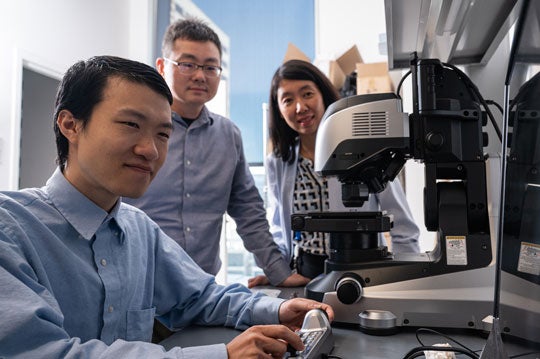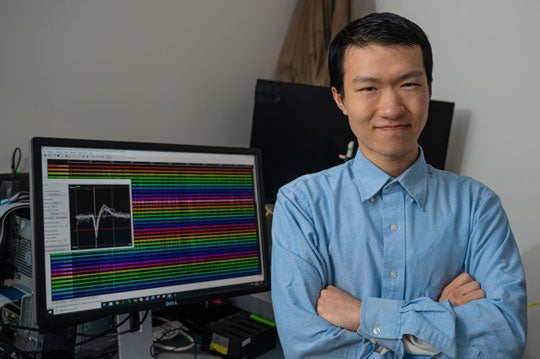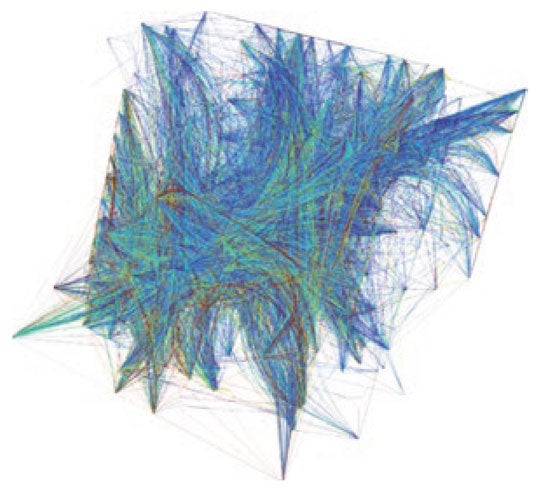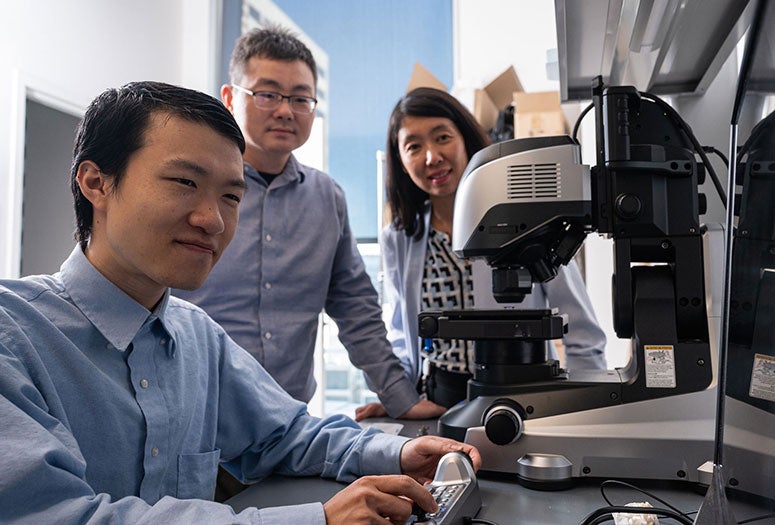HOUSTON – (Oct. 19, 2022) – It’s a mystery how human thoughts and dreams emerge from electrical pulses in the brain’s estimated 100 trillion synapses, and Rice University neuroengineer Chong Xie dreams of changing that by creating a system that can record all the electrical activity in a living brain.

In a recently published study in Nature Biomedical Engineering, Xie and colleagues described their latest achievement toward that goal, a 3D electrode array that allows them to map the locations and activity of up to 1 million potential synaptic links in a living brain based on recordings of the millisecond-scale evolution of electrical pulses in tens of thousands of neurons in a cubic millimeter of brain tissue.
“The thing that is novel about this work is the recording density,” said Xie, an associate professor of electrical and computer engineering at Rice and a core member of the Rice Neuroengineering Initiative. “Microcircuits in the brain are very mysterious. We don't have many ways to map their activity, especially volumetrically. We want to deliver very dense recordings of the cortex because those are important, scientifically, for understanding how brain circuits work.”
Xie collaborated on the study with colleagues from Rice and the University of California, San Francisco, including Loren Frank of UCSF and co-corresponding author Lan Luan of Rice.
Neurons are small. Each cubic millimeter of brain tissue contains about 100,000. That density is roughly the same for humans and other mammals, including the rodents that are the subject of experiments in Xie’s lab. The processing power of the brain arises from synaptic connections between neurons. Synaptically linked neuron pairs are connected by narrow bridges of tissue called axons, which are just a few millionths of a meter in diameter.

Xie’s team has spent years developing a material called nanoelectronic thread (NET) that is thin, ultraflexible and biocompatible, a trifecta of properties for making minimally invasive electrode implants. In previous studies, Xie’s team has demonstrated techniques for emplanting tightly packed NET arrays of up to 128 electrodes. The researchers also showed their arrays could stay in place for up to 10 months, recording the pulsed spikes of electricity, or action potentials, in nearby neurons.
“When neurons fire action potentials, there are very faint electrical signals coming out of them,” Xie said. “You have to place the electrodes very close to each neuron in order to capture that signal. Usually, that means a distance less than 100 microns.”
Using electrodes to record neuronal spikes has been a primary technique in neuroscience for decades, but the evolution of electrode materials has gradually transformed the implantation of neural electrodes from highly invasive procedures that damaged the very brain tissue the electrodes were meant to measure to procedures that result in no measurable tissue damage.
One of the primary focuses of Xie’s lab is scaling up the size of its implant arrays. In the new study, Xie and colleagues, including Hanlin Zhu, one of the lead graduate students on the project, implanted arrays of 1,024 NET electrodes in a 1 cubic millimeter volume of brain tissue.
“The primary signals we try to measure are the electrical spikes coming from neurons,” Xie said. “That's how they communicate. And one thing we care a lot about and really want to understand is how neurons are connected.”

Xie said there is no straightforward way to probe synaptic connections.
“Axons can be very long, and each neuron can be connected by many thousands of others,” he said. “It's a very, very, very messy network. And probing it is an extremely challenging task, especially while the brain is working.”
The density of the new electrode array, together with its ability to capture millisecond-by-millisecond changes in the electrical spikes of individual neurons allowed Xie and co-authors to decipher potential synaptic links between neuron pairs.
“When the synapse works, you usually see a typical pattern when you look at the firing activity of the two neurons,” Xie said.
It takes a bit of time for the electrical impulse that starts in the presynaptic neurons to propagate down the axon and activate the postsynaptic neuron, he said.

“We record many, many spikes, and then we need to sort the spikes and attribute each of them to individual neurons,” he said. “We know the location of each electrode, or channel. And each channel records no more than a few neurons at a time. Each neuron is also typically recorded by more than one contact as well. So, you can do something akin to triangulation to identify the location of individual neurons.”
Once the neurons are mapped, it’s relatively easy to calculate the distance between them and from that, the propagation time for synaptic activation.
The 1,024-electrode array gave Xie’s team a ratio of approximately one electrode per 100 neurons in the cubic millimeter volume of brain tissue under study. The lab is working to create denser arrays that pack more electrodes into the same volume.
The vast majority of neurons in people’s brains are unused, despite the fact that our brains typically consume about as much energy as can be supplied by the body. Neuroscientists don’t fully understand why the brain has so many unused neurons, and Xie said that’s a factor his team considers in the design of their electrode arrays.
“I want to capture as much of the interactivity as possible,” he said. “I would argue that we don't need a 1-to-1 ratio of electrodes to neurons to capture all of it, and it is indeed my dream to capture all the interactivity.”
The research was supported by the National Institute of Neurological Disorders and Stroke (R01NS102917, U01NS115588, R01NS109361, UF1NS107667), the National Heart, Lung and Blood Institute (K25HL140153), the Welch Foundation (F-1941-20170325) and the Howard Hughes Medical Institute.
- Peer-reviewed paper
-
“Ultraflexible electrode arrays for months-long high-density electrophysiological mapping of thousands of neurons in rodents” | Nature Biomedical Engineering | DOI: 10.1038/s41551-022-00941-y
Zhengtuo Zhao, Hanlin Zhu, Xue Li, Liuyang Sun, Fei He, Jason E. Chung, Daniel F. Liu, Loren Frank, Lan Luan and Chong Xie
- Image downloads
-
https://news-network.rice.edu/news/files/2022/10/1017_DENSE-fit43-lg.jpg
CAPTION: Rice University neuroengineers (from left) Hanlin Zhu, Chong Xie and Lan Luan have created a 3D array of more than 1,000 electrodes that can simultaneously record the millisecond-scale evolution of electrical pulses in tens of thousands of neurons in a living brain. (Photo by Jeff Fitlow/Rice University)https://news-network.rice.edu/news/files/2022/10/1017_DENSE-fit18-lg.jpg
CAPTION: Rice University neuroengineers (from left) Lan Luan, Hanlin Zhu and Chong Xie have created a 3D array of more than 1,000 electrodes that can simultaneously record the millisecond-scale evolution of electrical pulses in tens of thousands of neurons in a living brain. (Photo by Jeff Fitlow/Rice University)https://news-network.rice.edu/news/files/2022/10/1017_DENSE-fit3-lg.jpg
CAPTION: Rice University graduate student Hanlin Zhu of the Xie Lab is part of a team in the Rice Neuroengineering Initiative that created a 3D electrode array capable of simultaneously recording the millisecond-level electrical activity of tens of thousands of neurons in a living brain. (Photo by Jeff Fitlow/Rice University) (Photo by Jeff Fitlow/Rice University)https://news-network.rice.edu/news/files/2022/10/1017_DENSE-f1e-lg.jpg
CAPTION: A micro-CT scan shows some of the 1,024 flexible electrodes in a 3D neural array implanted in the visual cortex of a rodent. (Image courtesy of Xie Lab/Rice University)https://news-network.rice.edu/news/files/2022/10/1017_DENSE-f2b-lg.jpg
CAPTION: Using millisecond-scale recordings from a dense 3D array of electrodes, researchers in the laboratory of Rice University neuroengineer Chong Xie were able to map the locations and activity of up to 1 million potential synaptic links in a living brain. (Image courtesy of Xie Lab/Rice University) - Related stories
-
Gentle probes could enable massive brain data collection – Sept. 14, 2020
https://news.rice.edu/news/2020/gentle-probes-could-enable-massive-brain-data-collectionBlood flow recovers faster than brain in micro strokes – May 22, 2020
https://news.rice.edu/news/2020/blood-flow-recovers-faster-brain-micro-strokes - Links
-
Nanoscale Neural Interface Laboratory - Xie Lab: chongxie.net
Rice Neuroengineering Initiative: neuroengineering.rice.edu
George R. Brown School of Engineering: engineering.rice.edu
- About Rice
-
Located on a 300-acre forested campus in Houston, Rice University is consistently ranked among the nation’s top 20 universities by U.S. News & World Report. Rice has highly respected schools of Architecture, Business, Continuing Studies, Engineering, Humanities, Music, Natural Sciences and Social Sciences and is home to the Baker Institute for Public Policy. With 4,240 undergraduates and 3,972 graduate students, Rice’s undergraduate student-to-faculty ratio is just under 6-to-1. Its residential college system builds close-knit communities and lifelong friendships, just one reason why Rice is ranked No. 1 for lots of race/class interaction and No. 1 for quality of life by the Princeton Review. Rice is also rated as a best value among private universities by Kiplinger’s Personal Finance.

